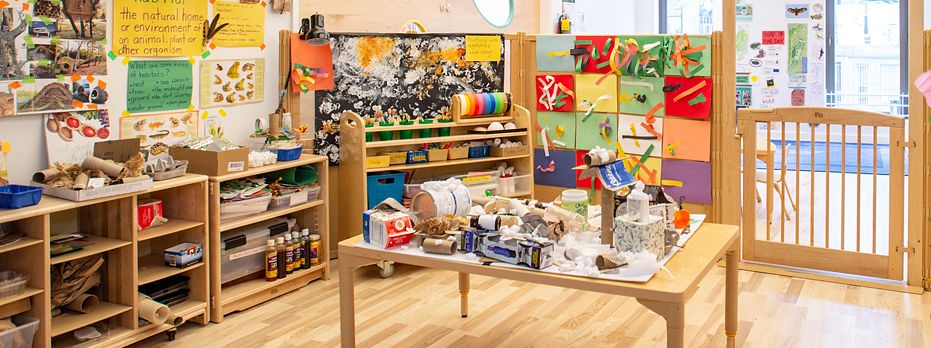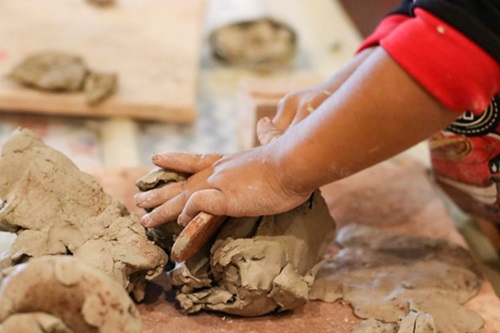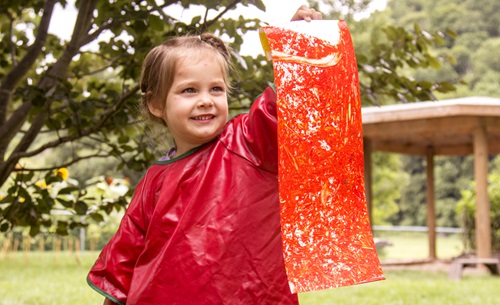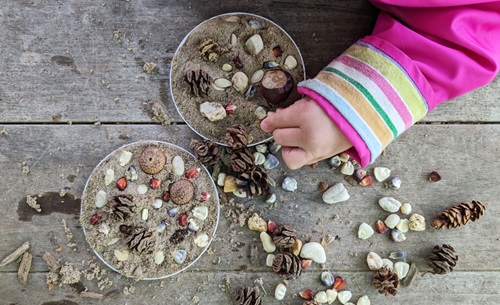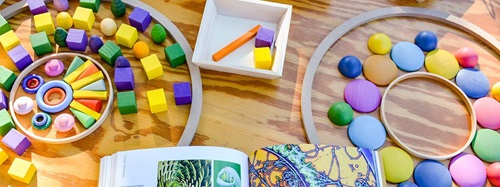A Letter to Families and Friends of the Children in Room 13
| May 2010Thank you for responding to our call for scrounge items. When you come to the open house next week, you’ll notice that our huge basket of stuff is almost empty! Look for former contents in our homemade instruments, inventions, puzzles, museum exhibits, collections, and constructions, and in our imaginative sculpture show in the gallery area. Amazing what our talented kindergarten artists and scholars can create from your cereal boxes, egg crates, coffee cans, toilet paper and paper towel rolls, clear plastic boxes, and fast-food Styrofoam containers. Please keep these excellent materials coming in, as we have many more things we can do with them, always. The children are becoming more aware of how often we just toss away such valuable materials, so our scrounge works to help our environment.
Thanks for answering the survey we sent out during the first week of school asking you to jot down any areas of your experience you’re willing to share with the children. We’ve already welcomed three honored guests and learned a lot from them:
- Adam’s grandfather told us about his work as a school custodian. The children listened intently as he talked about all the things he has to do to keep a school running smoothly and safely. They asked some very thoughtful questions.
- Anthony’s aunt taught the kids how to design and make lovely bead patterns and introduced them to braiding. Marvelous for small- and gross-motor skills. (And for counting, colors, and sorting.)
- Destiny’s mom told us about her job working in the house wares department of a big department store. The children loved the catalogs she shared and were fascinated by all the different household items and appliances she knew about.
Of course, all of our classroom guests received beautifully written and illustrated thank-you letters from each child.
Now, about Our Place. Some of you have expressed concern that the kindergartners in room 9 down the hall seem to be more focused on practicing basic skills than our children here in room 13. You were impressed with their seatwork, paperwork, and structured lessons. We respect the different ways children learn in our school, and we are eager to tell you about the developmentally appropriate practices approach we share with your children in Our Place. We deeply believe that the students in room 13 are learning their basic skills, but in diverse ways, which we will try to describe and which you’ll have the chance to see for yourselves at the open house next week (or anytime you care to visit us—you’re always welcome).
You may notice our room is a bit cluttered! So much is happening here that sometimes it’s impossible to get organized and neat (even for the open house).
Our dress-up center is very popular (thanks to you folks who sent in the clothing—the children love it). Our M. N. M. trio (Monte, Nicole, and Michele) is deeply into playing with their costumes first thing every morning. You can’t imagine all the oral language, vocabulary, listening skills, and social development that grow with dress-up dramas!
You’ll understand why we advocated for keeping our sandbox when you see how most of the children enjoy it. We think they must be the descendants of desert people! Especially Tiffany and Juan, who lead the group to the sand every free-activity time. Among their numerous projects are the building of tunnels, cities, and sandscapes and the discovering of buried treasures (they love playing archaeologists). Last week Latia joined in and surprised everyone by writing the whole alphabet in the sand. We called it sandmanship. The children learn so much about measuring—cups, pints, quarts, gallons—in their world of sand.
Be careful when you stop at the inventions lab. Lamar and Jennifer are deep at work on a very intricate invention-in-progress. We can’t wait for them to introduce it and explain it to us. Remember, these scientific breakthroughs take time, so we have to be patient. A lot of problem solving, decision making, and cooperative learning go into invention. They promised to try to finish it in time for our science fair (which you will learn about soon).
Have the children told you about their fabulous musical instruments? They’re constructed of and decorated with scrounge and found objects, in colorful and original ways. Every day we use our instruments for stories, parades, sound effects, math, science, and special events. In our weather study, we composed a blustery thunderstorm symphony. We enriched our math lesson by adding the sound of one instrument at a time until we could hear the sum of all the parts. Then we subtracted one after another until we had silence—zero. We like to compose rhythms using numbers and patterns. Of course, we can’t help dancing to our wonderful music! You would too! We often write down our choreography. For example, ten jumps, five kicks, ten jumping claps, two wiggle-wiggles, repeat. Easy to follow and so much fun to do. If we have time, we’ll demonstrate at the open house.
Room 13 is drenched in language! Words! Posters! Signs! Charts! Cartoon labels! Letters! Our word wall is packed with words the children suggest and recognize. Doesn’t it make great wallpaper? The class rules prominently posted on the door were discussed and agreed upon by the children. Our mailbox is bursting with mail, which gets delivered every day. It takes time to help the children write and read their letters. Their letter and word recognition and comprehension are strengthened every day in everything we do. Notice the postage stamps the children designed. They love to get mail!
The orange flipchart near the nature table is our songbook. Look through its large, bright pages. Read the words to all the songs your children know. Remember, the music teacher is on maternity leave, but we sing every day anyway. The children recognize every song and follow the words as we sing. Is this singing or reading? (We say it’s both!) We love the illustrations the children designed for each song.
Reading is happening all the time in Our Place. We don’t limit reading to one specific time slot. We’re almost finished with the Ananci stories. We read a story or poem every day after lunch. Our nature-loving students are immersed in books about butterflies, dinosaurs, fish, and volcanoes. All the children are fascinated by the variations of the Cinderella story told by people around the world. Even though the holidays are still far off, the children want to hear Michael Joel Rosen’s Elijah’s Angel over and over!
And our kids count! Numbers are everywhere in Our Place. We count days, months, colors, shoes, pockets, loose teeth, pebbles, clouds. We measure and graph everything! Right now, our birthday graph is very popular!
We mustn’t forget to tell you about the turtle. One of our colleagues from a nearby school was driving along when she saw a huge turtle in the middle of the road. Thrilled to find such a serendipitous treasure, thinking of how her second graders would love to meet such an interesting animal, she jumped out of her car to pick it up. As she carefully set it in the backseat, she remembered her school was committed to a rigid, tightly scheduled, solidly structured curriculum with little time for any diversion. Most of each day was spent preparing the children for testing, practicing skills and drills in a school-wide teaching program. Reluctantly, she gave the turtle to us.
We can’t begin to describe the countless ways our turtle has inspired rich and meaningful learning experiences! Check out the shelf of books about turtles the children are reading. Their questions about turtles fill our wonder chart and have started us off on research and adventures. You’ll learn from their turtle books and charts about different kinds of turtles, like snapping turtles, painted turtles, and box turtles. In the turtle log, next to the habitat they built, the children have written very interesting observations. You’ll see how their handwriting is growing clearer every day. Their vocabulary continually delights us. We’ve discovered many turtle legends and myths from different cultures. At the beginning of the year, we didn’t know that the turtle is a very important animal and symbol in many traditions! Did you? Next week at the open house, the children will present their own interpretation of the legend of Turtle Island, accompanied by original music, dialogue, chants, and dances. The costumes, props, and scenery were built from your scrounge materials. Soon you’ll receive your invitation to the program, made for you by your kindergartner.
Our newest classmate, Molly, who came from China last month, is learning more and more English each day, as all her class neighbors are excellent tutors and we do so much talking all the time. (How else to learn a language but to talk a lot?) Yesterday on our field trip to a nearby field, all the children wanted to hold Molly’s hand and be her helper as we celebrated our senses and wrote and drew impressions of our field study in our sketchbooks.
When you come to the open house, you’ll see our classroom helpers board, with jobs for every child every day. Many of the twenty-four jobs were suggested by the kids. It takes all of us working together to contribute to the success and happiness of our group.
Included in the open-house packet you’ll receive next week will be a description of developmentally appropriate practices from the National Association for the Education of Young Children, as well as an informational sheet about the multiple intelligences. (We all learn through and from our own unique mix of strengths and interests.)
We’re eager to welcome you and tell you how much we love your children and how happy we are to be with them in Our Place, room 13.
Sincerely,
The Teachers of the Children in Room 13
P.S. We’ve had a few instances when children were really sick (fever, etc.) but tried to hide their symptoms so they could come to school. The third-grade brother of one of our students explained that his sister was “playing healthy” so she wouldn’t miss. We were flattered but are concerned about their well-being. Thank you.
From Celebrating Young Children and Their Teachers: The Mimi Brodsky Chenfeld Reader by Mimi Brodsky Chenfeld. Copyright © 2007 by Mimi Brodsky Chenfeld. Reprinted with permission of Redleaf Press,
St. Paul, MN; www.redleafpress.org.

